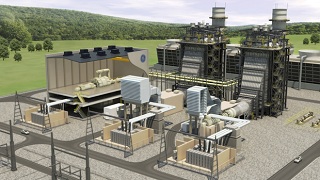GE's bet on natural gas, renewable energy pays off
 General Electric announced today nearly $1.2 billion in new orders from power producers in the U.S., Japan and Saudi Arabia for heavy-duty gas turbines designed to start up or slow down rapidly to allow more renewable energy to be integrated into the grid.
General Electric announced today nearly $1.2 billion in new orders from power producers in the U.S., Japan and Saudi Arabia for heavy-duty gas turbines designed to start up or slow down rapidly to allow more renewable energy to be integrated into the grid.The orders are all from GE’s FlexEfficiency 60 power generation portfolio, a series of four models of gas turbines. The company’s flagship model is the FlexEfficiency 60 combined cycle power plant, which has the capability to reach greater than 61 percent thermal efficiency, saving fuel and money and reducing emissions, the company said.
The power plant avoids 56,000 metric tons of carbon emissions per year relative to existing technology, GE said. Replacing one coal plant of similiar size would offset 2.6 million metric tons of carbon emissions annually, equivalent to taking 500,000 U.S. cars off the road.
The $1.2 billion in new sales is comprised of orders for 19 gas turbines for Japanese utility Chubu Electric Power, the Riyadh Power Plant in Saudi Arabia, the Cherokee Clean Air Clean Jobs project in Colorado, Hess Corp., and an unidentified customer in the United States. The gas turbines will be manufactured at GE’s Greenville, South Carolina plant.
GE unveiled its first FlexEfficiency natural gas power plant in May 2011, which was designed to operate at 50 Hz, the power frequency most used in countries around the world, including Europe and large swaths of Asia. At the time, GE said it would eventually release a 60 Hz version of its FlexEfficiency plant, which could be used in the U.S., much of South America, Saudi Arabia, southern Japan, Korea and Taiwan.
The company’s expansion into North America and other 60 Hz markets signals utilities and other industrial users’ shift away from coal and towards natural gas. It also illustrates a growing interest in bringing on more solar and wind energy onto the grid.
Solar and wind suffers from variability. Meaning, when the wind stops blowing and the sun sets, renewable power sources drop off, creating headaches for grid operators trying to maintain a a steady electricity supply. GE designed its combined-cycled power plants to accommodate those fluctuations, helping to smooth out the electricity supply, save wasted energy, increase efficiency and allow for more renewable energy to be integrated into the power grid.
You can return to the main Market News page, or press the Back button on your browser.

